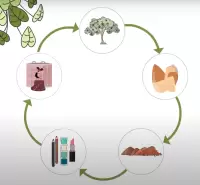Why Bio-Based Composites?
The debate about replacing plastics has not only deeply affected consumer items, but also advanced material science. While products of daily use such as packaging or single-use items are being phased out at a fast pace, technologically advanced plastics are the focus of diverse new developments. The central idea of both is to replace petroleum-derived raw materials by plant-based or renewable ones. In this context, bio-composites have proven to be a success over the last years.
What does it take to create aircraft or shipbuilding parts, flooring panels or medical implants that ensure high performance and sustainability at the same time? And how can plastic materials be sustainable without multiplying the manufacturing costs? These questions have led to the development of new compounding technologies.

Compounding Methods and Applications
Early-stage composites were compounds consisting of a petrochemical base polymer reinforced with fibers. A wide range of materials has been used: glass, carbon fiber, wood, hemp and finally olive stones or other granules. Engineering solutions have been created to ensure cutting-edge production of such composites and to meet the requirements of diverse markets. Filament lining facilities, extrusion and injection technlologies - just to name a few. Especially wood plastic composite production lines are characterized by a strong output capacity at a reasonable cost. This has made composites sought-after materials for a number of construction and industrial items such as
- deckings (for ships, floors, tarraces, etc.) and roofing panels
- automotive and nautical parts such as hulls and car bodies
- aerospace parts, e.g. aircraft fuselage, wings and interior claddings
- sports equipment, e.g. skis, surfboards, tennis and hockey rackets
- fully biodegradable coffins and funeral urns
- windmill blades, furniture and design objects....and much more.

Over time, the polymer component of composites has frequently been replaced by bio-based resins (sometimes also referred to as thermosets). The constituents of these monumers are derived from renewables, i.e. plants like corn, soybeans or other crops. Growing concerns about minimizing our ecological footprint have led researchers to look at by-product sources. To avoid the need for cultures and any competition with the food chain, alternatives derived from olive stones have been explored with great success. Micronized granules are short fibers with an appealing color, lasting texture and medium density - characteristics that have proven to enhance a series of material properties. Their use in composites is generally two-fold: as a fibre to reinforce conventional polymers or as a resin filler.
Outlook: The Future of Bio-Composites
There is continuous innovation to achieve optimized combinations of resistance, stability, light weight, texture, haptics and other user-centered characteristics with a maximum bio-based percentage. Latest inventions include rubber composites (acrylonitrile butadiene rubber), devulcanized rubber, olive stone filled polypropylene composites, reinforced polysterene composites.
But what are the benefits of fibre-reinforced composite materials? Research has shown that, besides the ecological advantages, the natural fibers allow for faster cooling and curing times during manufacturing. Injection molding times can therefore be significantly reduced, offering cost savings and faster cycles. Other aspects of value are the various ways of creating different surface textures with a natural look. Objects formed of olive stone composites can have an appealing haptic and are easy to coat and color with bio-based agents. Moreover, the relatively low density of fruit stone fillers and fibers can facilitate the production of light-weight composites with ideal resistance and elasticity features. Last but not least, a high percentage of natural constituents enhances recyclability of composites; in other words, resource-saving disposal and ultimately an improved CO2 balance.

According to Composites Manufacturing Magazine, the biocomposite market is expected to grow by 7.9% between 2018 and 2023, generating an estimated revenue of US$7.6 billion . A number of funding opportunities, above all under the EU Horizon 2020 scheme, are available to support innovators in all stages of composite research, development and marketing.




